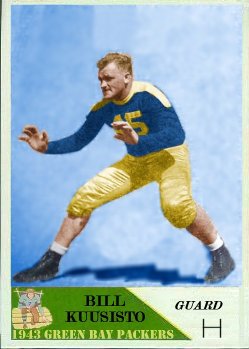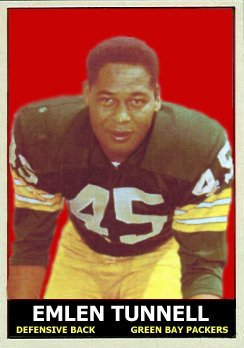Three members of the team’s Hall of Fame were born on August 16: tackle Dick Wildung, kicker Ryan Longwell and safety Nick Collins.
A three-year starter at tackle for the University of Minnesota, Wildung played for two undefeated national championship teams, made All-America in both 1941 and 1942 and was the Gophers MVP in his senior year. He was the top draft pick of the Packers in 1943, but was not able to join them until 1946 after being discharged following three years in the Navy.
In Green Bay, the 6’2” 220 pounder was joined by two of his college teammates, fellow tackle Urban Odson and Heisman Trophy-winner Bruce Smith, but Dick had the longest and best pro career of the three. Wildung played on both offense and defense for the Packers and even played guard in 1947. He was especially noted for his quickness, which is not surprising considering his moderate size. The Packers were in a state of decline during his tenure, but he was one of the few stars on the team. He recalled the end of the Lambeau era to Jerry Poling for Downfield!, “The game kind of passed Curly by. We were still playing the Notre Dame Box and everyone else was in the T-formation.”
When Gene Ronzani replaced Lambeau in 1950, he offered Wildung and linebacker Bob Forte, also a future Packer Hall of Famer, to the Lions for inconsistent young quarterback Frank Tripucka but fortunately was turned down. Both Wildung and Forte were still starting for the Pack when Ronzani was canned in 1953, so Wildung liked to joke that he and Forte “got rid of the only two coaches the Packers ever had.”
Wildung, who sat out the 1952 season to attend to his hardware store, retired for good following the 1953 season. He was a college player of distinction, a member of the College Football Hall of Fame, and as a pro, he was a respected player–team captain for four years.
The 49ers signed Ryan Longwell out of UC-Berkeley as an undrafted free agent in 1997, but he lost out to 38-year old veteran free agent Gary Anderson in the team’s kicking competition that July. Signed by the defending world champion Packers to compete with third round draft choice Brett Conway of Penn State, Longwell bested the injury-hampered Conway to begin a nine-year career in Green Bay that would make him the team’s all-time leading scorer.
The 6’1” 185-pound Longwell never had the strongest leg in the league and never was selected to a Pro Bowl, but he was accurate and consistent despite dealing with the sometimes treacherous weather conditions in the NFC Central. In his nine years as a Packer, he hit on 45 of 55 (81%) of his December kicks at home, while opponents in those games converted 21 of 29 (72.4%).
He was calm and steady and based his kicking on rhythm and timing. He later told the Journal Sentinel, “Concentrating on rhythm instead of mechanics allowed me to avoid long slumps kickers can go through.” His one bad year was 2001 when his field goal percentage dropped to 64.5%, but the next year he returned to form converting 82.4% as a primarily outdoor kicker. His last year in Green Bay, 2005, was the only other year of his 15-year NFL career that his field goal percentage dipped below 80%, and that dip was due primarily to problems with holder B.J. Sander.
Although he missed his first chance at a game-winning field goal against the Eagles in his rookie year, he blasted 10 game-winners in his Packer tenure. He scored more than 100 points for his first eight years in Green Bay with a high of 131 in 2000; when he left for Minnesota as a free agent in 2006, he had scored a team record 1,054 points as a Packer
Green Bay drafted Nick Collins out of Bethune-Cookman in the second round in 2005 to replace Darren Sharper, who left as a free agent. Collins came from a small school but was a big-time player. While Collins was filling Sharper’s position, he was given Leroy Butler’s number and, indeed, played more like the physical Butler than Sharper.
Collins was a solid tackler and vocal leader who started at free safety as a rookie. By his fourth season, 2008, he began a string of three consecutive seasons in the Pro Bowl and attracting All-Pro notice. That fourth season, Collins returned three interceptions for touchdowns and led the league in interception return yards on his seven picks. He had a nose for the ball and provided quality deep support for the Packer pass defense.
He is most remembered for his first quarter interception of Ben Roethlisberger in Super Bowl XLV. He broke quickly on that underthrown pass, grabbed it at the Pittsburgh 37, weaved skillfully through a sea of defenders and leaped into the end zone for the score that put Green Bay up 14-0. Sadly, seven months later, Collins was carted off the field after sustaining a neck injury while attempting to tackle Jonathan Stewart of the Panthers in week two of the 2011 season. Nick was part of a long sad line of Packers to have their careers end due to neck injuries over the last 30 years, including Tim Lewis, Sterling Sharpe and Mark Chmura, as well as eight others since 2000.



Wildung custom card is colorized.



































































